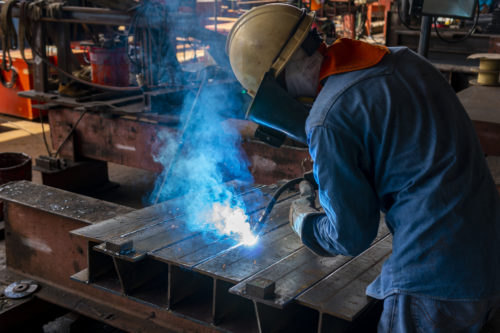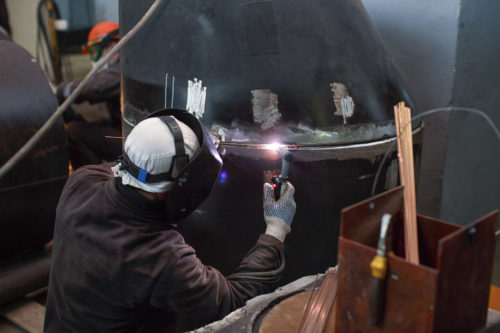Resistance welding is a welding technique in which pressure and an electric current are applied to two pieces of metal, causing the metal to melt and form a weld. The resistance welding process requires no other materials, making it a highly cost-effective method of joining metals. There are many different types of resistance welding techniques, each of which has a different welding application suitable for particular situations.
FCAW (Flux Core Arc Welding)
The flux core arc welding (FCAW) process utilizes heat from an electrical arc to fuse base metals. The arc forms between the workpiece and the continuously fed wire electrode, both of which melt together to form a weld joint. This process is similar to MAG welding except instead of a solid metal electrode, the electrode is hollow, tubular, and filled with flux. 
FCAW can be done in two different ways: one that utilizes a shielding gas and one that relies on the flux core alone. With the shielding gas method, shielding gas is provided by a high-pressure gas cylinder to protect the weld pool from oxidation. Common shielding gases include carbon dioxide or a combination of carbon dioxide and argon. This method is preferred when welding thicker metals and delivers welds with consistent mechanical properties and fewer defects.
When performed without shielding gas, FCAW relies on the flux cored electrode to provide gaseous protection. The electrode also produces a slag that covers and protects the molten metal within the weld. This method is extremely portable and can be performed outdoors since there is no need for external shielding gas.
GMAW (Gas Metal Arc Welding)
Gas metal arc welding (GMAW) can be divided into two types: metal inert gas (MIG) and metal active gas (MAG). Each type uses heat from a DC electric arc between the workpiece and a consumable metal electrode, which both melt together to form a weld pool and create the weld joint.
In GMAW processes, the wire electrode is fed from the contact tip of a wire feeding spool gun, and shielding gas is fed through the welding torch to protect the weld from oxidation. With MIG and MAG welding, a compatible filler material must be used. For example, an aluminum wire needs to be used when welding an aluminum workpiece, and steel welding requires a steel filler wire.
MIG and MAG welding differ primarily in the type of shielding gas used. For MIG, inert gases such as helium and argon are used to weld nonferrous metals like aluminum. MAG uses active shielding gases that typically consist of carbon dioxide, argon, and oxygen to weld steel materials.
GTAW (Gas Tungsten Arc Welding)
Gas tungsten arc welding (GTAW), or tungsten inert gas (TIG) welding, is a type of arc welding  that produces the weld using a non-consumable tungsten electrode to produce the weld. The process requires shielding gas such as helium or argon to protect the welded area from contamination, and most applications will need filler metal. GTAW is a very clean welding method and requires a great deal of skill and training. It also doesn’t produce slag, making it suitable for applications requiring an attractive and neat appearance.
that produces the weld using a non-consumable tungsten electrode to produce the weld. The process requires shielding gas such as helium or argon to protect the welded area from contamination, and most applications will need filler metal. GTAW is a very clean welding method and requires a great deal of skill and training. It also doesn’t produce slag, making it suitable for applications requiring an attractive and neat appearance.
Hardwire
The most common type of wire used with MIG welding is hardwire. Hardwire works best with a mix of 75% argon and 25% carbon dioxide. There are several types of hardwire, all of which are used in welding mild steel and have varying levels of hardness. Hardwire does not produce slag, making it one of the most efficient welding processes. It can also be used to weld in any position, including horizontal, diagonal, downhill, uphill, flat, and overhead.
Trade Tech: Your Certified Welding Experts
At Trade Tech, our certified welding experts are skilled in a wide range of arc and resistance welding processes, including MIG welding, TIG welding, FCAW, GMAW, and GTAW. We maintain certifications in AWS D1.1, AWS D1.6, and AWS D14.1, and we invest in the latest welding equipment to ensure precision welds for industries such as mining, nuclear power, and industrial equipment. To learn more about our certified welding capabilities, contact us today or request a quote for your next project.
